High Resolution Monitoring of River Bluff Erosion Reveals Failure Mechanisms and Geomorphically Effective Flows
Abstract
:1. Introduction
2. Methods
2.1. Study Sites
2.2. Data Aquisition
2.2.1. Daily Time Lapse Photographs
2.2.2. Repeat Topographic Surveys using Structure-from-Motion Photogrammetry
2.3. Data Analysis
2.3.1. Inventory and Classification of Bluff Erosion Events
2.3.2. Measuring Bluff Erosion using Structure-from-Motion Photogrammetry
2.3.3. Estimating Bluff Erosion using Daily Photographs and Volume-Area Scaling Relation
2.3.4. Identifying Geomorphically Effective Flows
3. Results
3.1. Daily Photographs Reveal Bluff Erosion Timing, Frequency, and Seasonal Failure Mechanisms
3.2. Structure-from-Motion Measured Bluff Erosion Volumes, Distances, and Rates
3.3. SfM- and TLS-Derived Geometry Relations for Estimating Bluff Erosion from Daily Photographs
3.4. Geomorpically Effective Flows for Bluff Erosion
4. Discussion
4.1. Bluff Failure Timing, Frequency, and Seasonality
4.2. Measured Bluff Erosion
4.3. Generalizability of Our Volume-Area Scaling Relation
4.4. Geomorpically Effective Flows for Bluff Erosion
5. Conclusions
- Fluvial erosion was much more important than freeze–thaw and other subaerial processes during our study period, 2014–2017. The 13- and 25-year flood events caused 79–97% of the total erosion measured at two bluff sites on the Le Sueur River. Fluvial erosion is also the dominant long-term process driving bluff erosion, as toe colluvium must be removed by flows in order to continue bluff face erosion. In this way, the process of bluff erosion is very similar to landslide erosion, in which erosion rates are controlled by fluvial incision and uplift rates [47].
- Freeze–thaw and spring snowmelt influence bluff erosion rates between November and April. These processes exert greater influence on annual bluff erosion rates during low flow years. It is uncertain how climate change may amplify or dampen the importance of freeze–thaw processes in the Midwest USA, presenting opportunities for future researchers to expand upon frontiers in hillslope and fluvial geomorphology.
- Bluff erosion follows a power-law volume-area scaling relation with an exponent of 1.4, which is consistent with volume-area scaling found by Larsen et al. 2010 for landslides in weak bedrock [47].
- We captured two very large floods during a relatively short study period and thus measured 5.5× higher rates of annual bluff erosion than Day et al. 2013a and 2013b.
- Modest, 15% exceedance probability floods (30% of the 2-year recurrence interval flow), are capable of inducing bluff erosion.
- Considering only the relatively short period of time that we directly monitored bluff erosion, we found that the vast amount of geomorphic work was done by the 13- and 25-year recurrence interval flows.
- Using daily runoff frequency, estimated bluff face erosion magnitude, and their product as a function of daily runoff, the most “geomorphically effective” flow for bluff erosion from 1940 to 2017 was the 1.5 mm/day or 1.2-year recurrence interval flood. Coincidently, this is the minimum flow necessary for measureable toe erosion, though future work should better constrain bluff toe erosion as a function of discharge.
Supplementary Materials
Acknowledgments
Author Contributions
Conflicts of Interest
Appendix A
| Site Name 1 | Site Description 2 | Aspect (°) | Survey Dimensions L(m) × H(m) | Easting (m) | Northing (m) | Photo Dates | Days w/Photos (%) |
|---|---|---|---|---|---|---|---|
| BE1 | NC, TC, FA | 153 | 22 × 7 | 412,910 | 4,877,097 | 6/9/2015–5/16/2017 | 98 |
| BE2 | NC, IS, OC | 229 | 26 × 14 | 413,266 | 4,877,247 | 6/8/2015–5/16/2017 | 83 |
| BE3 | NC, IS, OC | 174 | 24 × 11 | 413,786 | 4,878,851 | 6/9/2015–5/16/2017 | 100 |
| MPL1 | NC, IS, OC | 274 | 20 × 10 | 414,108 | 4,870,395 | 6/4/2015–5/12/2017 | 94 |
| MPL2 | NC, IS, OC | 180 | 20 × 11 | 414,145 | 4,870,844 | 6/5/2015–5/12/2017 | 100 |
| MPL3 | OC | 193 | 22 × 9 | 415,540 | 4,873,137 | 6/7/2015–5/13/2017 | 99 |
| MPL4 | NC, TC, FA | 69 | 21 × 6 | 416,018 | 4,874,079 | 6/7/2015–5/13/2017 | 92 |
| MPL5 | NC, TC, FA | 116 | 17 × 6 | 415,988 | 4,874,321 | 6/8/2015–5/13/2017 | 100 |
| MPL6 | OC | 166 | 21 × 13 | 416,435 | 4,875,258 | 6/8/2015–3/16/2016 | 70 |
| MPL7 | OC, TC, IS | 170 | 20 × 14 | 418,051 | 4,878,666 | 6/8/2015–3/29/2017 | 99 |
| LS1 | OC | 292 | 18 × 7 | 424,457 | 4,884,466 | 5/22/2015–5/18/2017 | 80 |
| LS2 | NC, TC, FA | 228 | 23 × 12 | 424,533 | 4,884,155 | 7/11/2015–5/13/2017 | 95 |
| LS3 | NC, IS, OC | 118 | 23 × 17 | 423,608 | 4,883,232 | 6/7/2015–5/14/2017 | 91 |
| LS4 | NC, OC | 36 | 23 × 13 | 422,105 | 4,882,098 | 6/7/2015–5/14/2017 | 84 |
| LS5 | OC, TC, FA | 180 | 20 × 6 | 421,975 | 4,882,474 | 6/7/2015–5/13/2017 | 58 |
| LS6 | OC, TC, FA | 138 | 20 × 9 | 421,918 | 4,882,463 | 6/8/2015–5/14/2017 | 98 |
| LS7 | OC, TC, FA | 262 | 28 × 11 | 420,202 | 4,881,018 | 6/7/2015–5/13/2017 | 99 |
| LS8 | OC, TC, FA | 222 | 23 × 7 | 419,815 | 4,881,174 | 6/7/2015–3/10/2016 | 68 |
| LS9 | NC, IS | 70 | 21 × 20 | 418,666 | 4,881,123 | 6/3/2014–5/15/2017 | 82 |
| LS10 | OC, TC, FA | 270 | 21 × 16 | 419,186 | 4,881,486 | 6/2/2014–5/15/2017 | 93 |
| Site Name | Survey 1 Date | Survey 2 Date | Survey Area (m2) | Net Volume Lost (m3) | Retreat Rate (m/year) | Erosion Area (m2) | Erosion Volume (m3) |
|---|---|---|---|---|---|---|---|
| LS9 | 6/15/2014 | 7/3/2014 | 1938.8 | 1082.0 | 11.3 | 451.0 | 1163.0 |
| LS9 | 6/15/2014 | 5/8/2015 | 1928.3 | 1229.0 | 0.71 | 538.0 | 1254.0 |
| LS9 | 6/15/2014 | 7/12/2015 | 1930.3 | 1132.6 | 0.55 | 604.0 | 1335.0 |
| LS9 | 6/15/2014 | 5/24/2016 | 1834.0 | 785.0 | 0.22 | 667.0 | 1524.0 |
| LS9 | 6/15/2014 | 10/22/2016 | 1931.6 | 3826.0 | 0.84 | 1129.0 | 3837.0 |
| LS9 | 6/15/2014 | 5/17/2017 | 1857.9 | 3759.0 | 0.69 | 1119.0 | 3785.0 |
| LS9 | 7/3/2014 | 5/8/2015 | 2111.3 | 131.2 | 0.07 | 191.0 | 207.0 |
| LS9 | 7/3/2014 | 7/12/2015 | 2297.2 | 117.2 | 0.05 | 424.0 | 381.0 |
| LS9 | 7/3/2014 | 5/24/2016 | 2138.7 | −224.1 | −0.06 | 716.0 | 841.0 |
| LS9 | 7/3/2014 | 10/22/2016 | 2318.4 | 3275.3 | 0.61 | 1533.0 | 3279.0 |
| LS9 | 7/3/2014 | 5/17/2017 | 2190.0 | 3117.3 | 0.50 | 1452.0 | 3146.0 |
| LS9 | 5/8/2015 | 7/12/2015 | 2157.2 | −113.0 | −0.29 | 276.0 | 221.0 |
| LS9 | 5/8/2015 | 5/24/2016 | 2037.8 | −481.6 | −0.23 | 576.0 | 655.0 |
| LS9 | 5/8/2015 | 10/22/2016 | 2130.4 | 2674.6 | 0.86 | 1217.0 | 2682.0 |
| LS9 | 5/8/2015 | 5/17/2017 | 2037.0 | 2597.7 | 0.65 | 1229.0 | 2626.0 |
| LS9 | 7/12/2015 | 5/24/2016 | 2385.2 | −355.0 | −0.17 | 646.0 | 817.0 |
| LS9 | 7/12/2015 | 10/22/2016 | 2713.6 | 3598.3 | 1.04 | 1562.0 | 3604.0 |
| LS9 | 7/12/2015 | 5/17/2017 | 2756.5 | 3256.9 | 0.64 | 1488.0 | 3292.0 |
| LS9 | 5/24/2016 | 10/22/2016 | 2227.2 | 3513.2 | 3.81 | 1419.0 | 3662.0 |
| LS9 | 5/24/2016 | 5/17/2017 | 2250.5 | 3240.0 | 1.47 | 1358.0 | 3462.0 |
| LS9 | 10/22/2016 | 5/17/2017 | 2616.1 | −324.6 | −0.22 | 412.0 | 316.0 |
| LS10 | 6/15/2014 | 7/3/2014 | 1420.6 | 1086.7 | 15.5 | 574.0 | 1270.0 |
| LS10 | 6/15/2014 | 5/9/2015 | 1396.9 | 1210.0 | 0.97 | 870.0 | 1551.0 |
| LS10 | 6/15/2014 | 7/10/2015 | 1410.9 | 1302.0 | 0.85 | 916.0 | 1729.0 |
| LS10 | 6/15/2014 | 5/24/2016 | 1390.9 | 1174.0 | 0.43 | 908.0 | 1751.0 |
| LS10 | 6/15/2014 | 10/22/2016 | 1372.1 | 2225.0 | 0.69 | 1140.0 | 2242.0 |
| LS10 | 6/15/2014 | 5/17/2017 | 1363.2 | 2182.0 | 0.55 | 1003.0 | 2291.0 |
| LS10 | 7/3/2014 | 5/9/2015 | 1807.6 | 139.9 | 0.09 | 582.0 | 686.0 |
| LS10 | 7/3/2014 | 7/10/2015 | 2021.3 | 325.0 | 0.16 | 1144.0 | 831.0 |
| LS10 | 7/3/2014 | 5/24/2016 | 2005.3 | 366.0 | 0.10 | 983.0 | 1365.0 |
| LS10 | 7/3/2014 | 10/22/2016 | 1984.9 | 1958.0 | 0.43 | 1436.0 | 1965.0 |
| LS10 | 7/3/2014 | 5/17/2017 | 1969.9 | 1857.0 | 0.33 | 1258.0 | 2329.0 |
| LS10 | 5/9/2015 | 7/10/2015 | 1947.7 | 380.3 | 1.08 | 414.0 | 582.0 |
| LS10 | 5/9/2015 | 5/24/2016 | 1941.6 | 599.0 | 0.30 | 718.0 | 949.0 |
| LS10 | 5/9/2015 | 10/22/2016 | 1915.8 | 2009.0 | 0.72 | 1085.0 | 2011.0 |
| LS10 | 5/9/2015 | 5/17/2017 | 1901.9 | 2070.0 | 0.55 | 1148.0 | 2237.0 |
| LS10 | 7/10/2015 | 5/24/2016 | 2587.2 | 396.7 | 0.18 | 719.0 | 628.0 |
| LS10 | 7/10/2015 | 10/22/2016 | 2807.7 | 2691.0 | 0.75 | 1371.0 | 2708.0 |
| LS10 | 7/10/2015 | 5/17/2017 | 2800.3 | 2650.0 | 0.51 | 1671.0 | 2852.0 |
| LS10 | 5/24/2016 | 10/22/2016 | 2607.7 | 2219.6 | 2.06 | 1082.0 | 2293.0 |
| LS10 | 5/24/2016 | 5/17/2017 | 2580.9 | 2127.0 | 0.84 | 1401.0 | 2340.0 |
| LS10 | 10/22/2016 | 5/17/2017 | 2890.8 | −130.3 | −0.08 | 673.0 | 895.0 |
| Survey Dates | Data, Authors/Source/Method | Measured, Retreat (m/year) ± 95% CI | Q (mm/day), est. Retreat (m/year), γ = 0.66 | Q (mm/ day), est. Retreat (m/year), γ = 0.67 | Q (mm/ day), est. Retreat (m/year), γ = 1.00 | Q (mm/day), est. Retreat (m/year), γ = 1.35 |
|---|---|---|---|---|---|---|
| January 1938–December 2005 | D13b/AP/Crest retreat | 0.14 ± 0.02 | 0.47 1 | 0.42 1 | 0.68 1 | 1.03 1 |
| July 2007–June 2010 | D13a/TLS/Site ero. | 0.20 ± 0.04 | 0.68 | 0.62 | 1.03 | 1.67 |
| June 2014–May 2017 | K&B/SfM/Site ero. | 1.19 ± 0.87 | 1.32 2 | 1.20 | 1.99 | 3.26 |
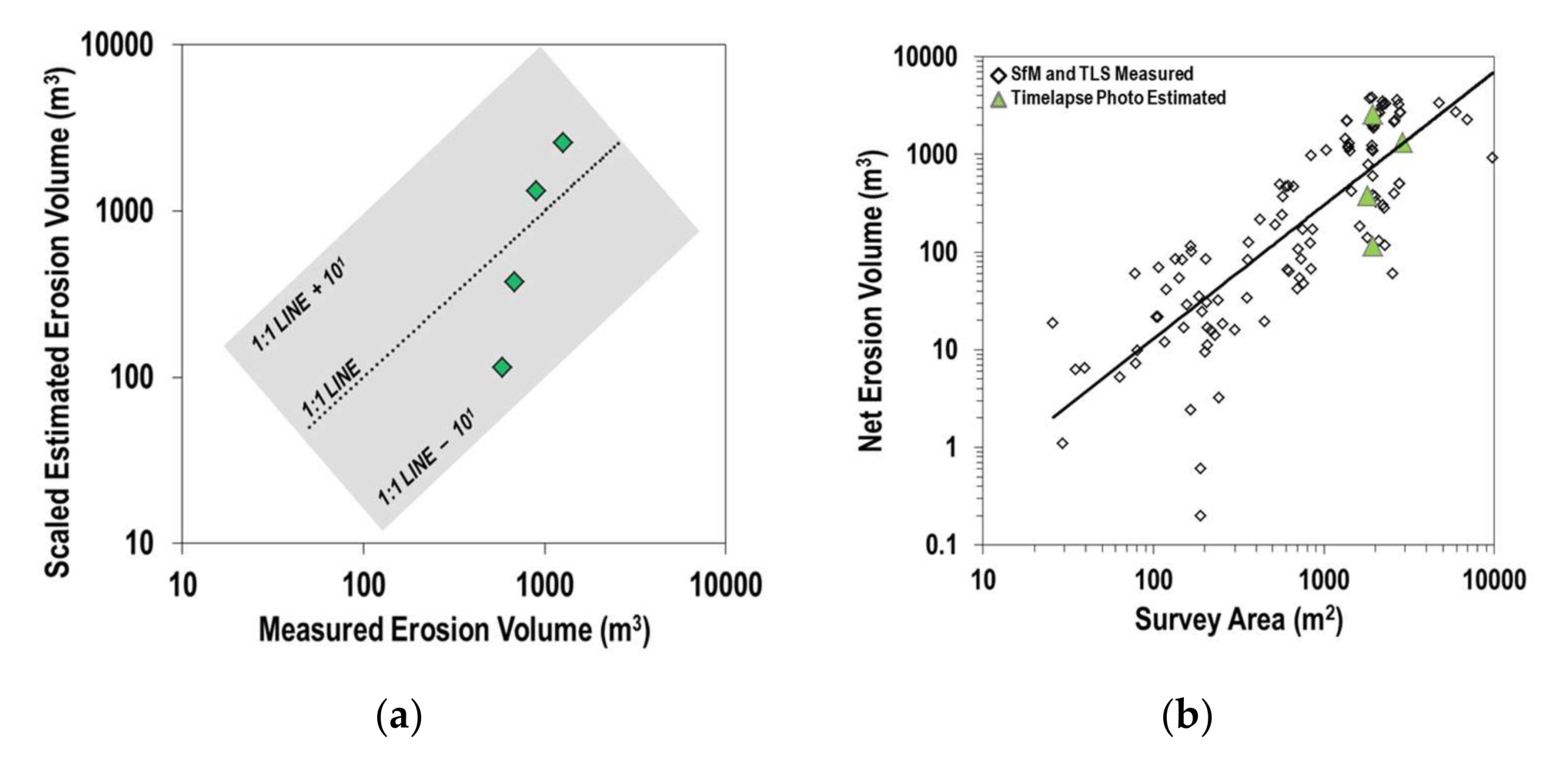
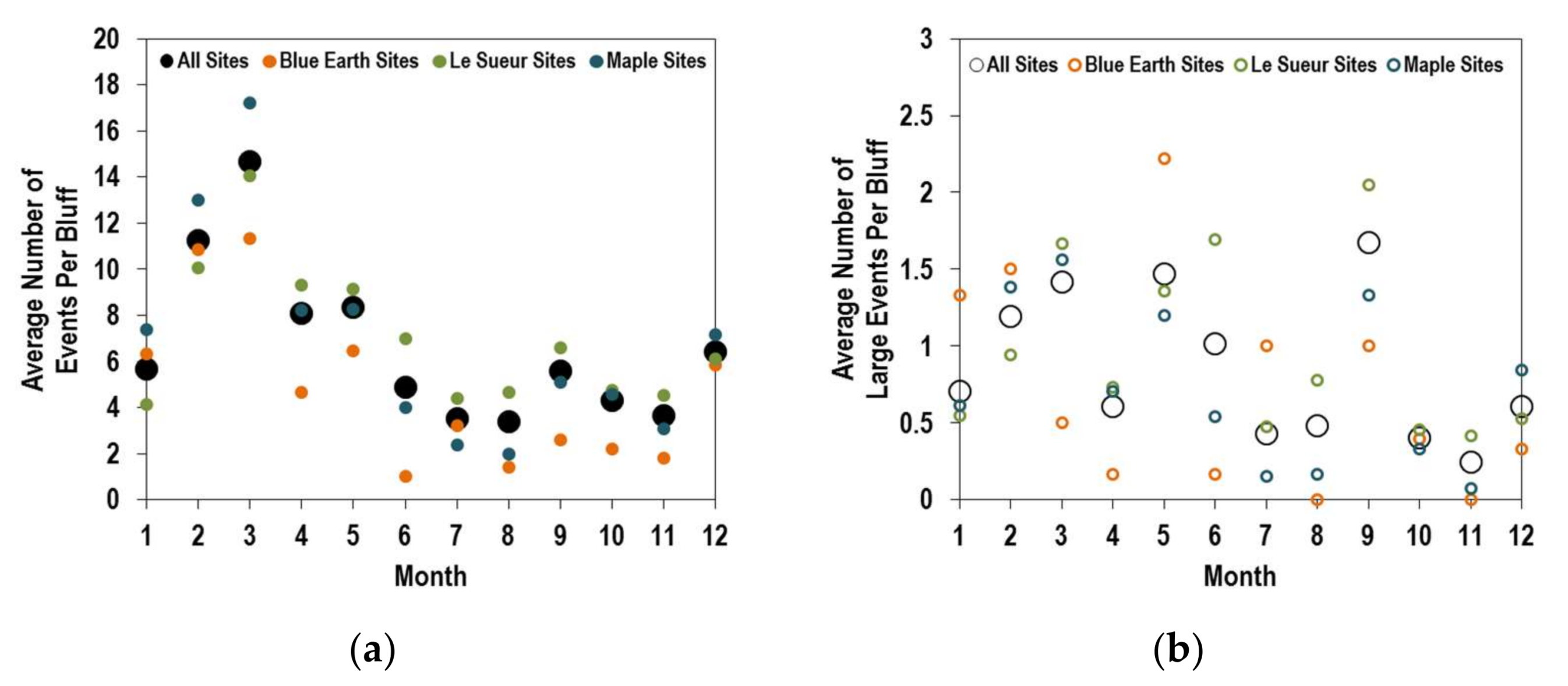

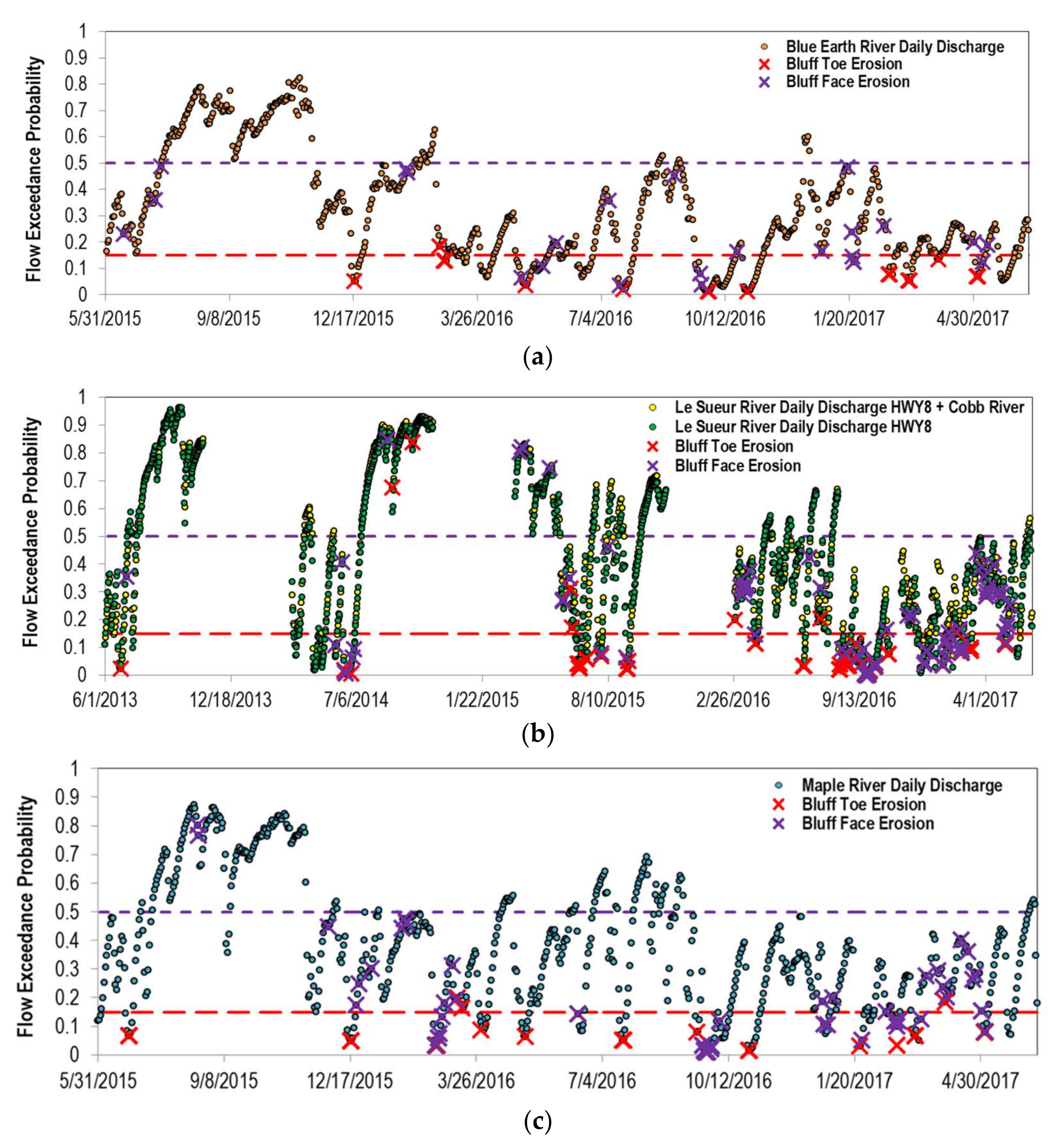
Appendix B
Appendix C
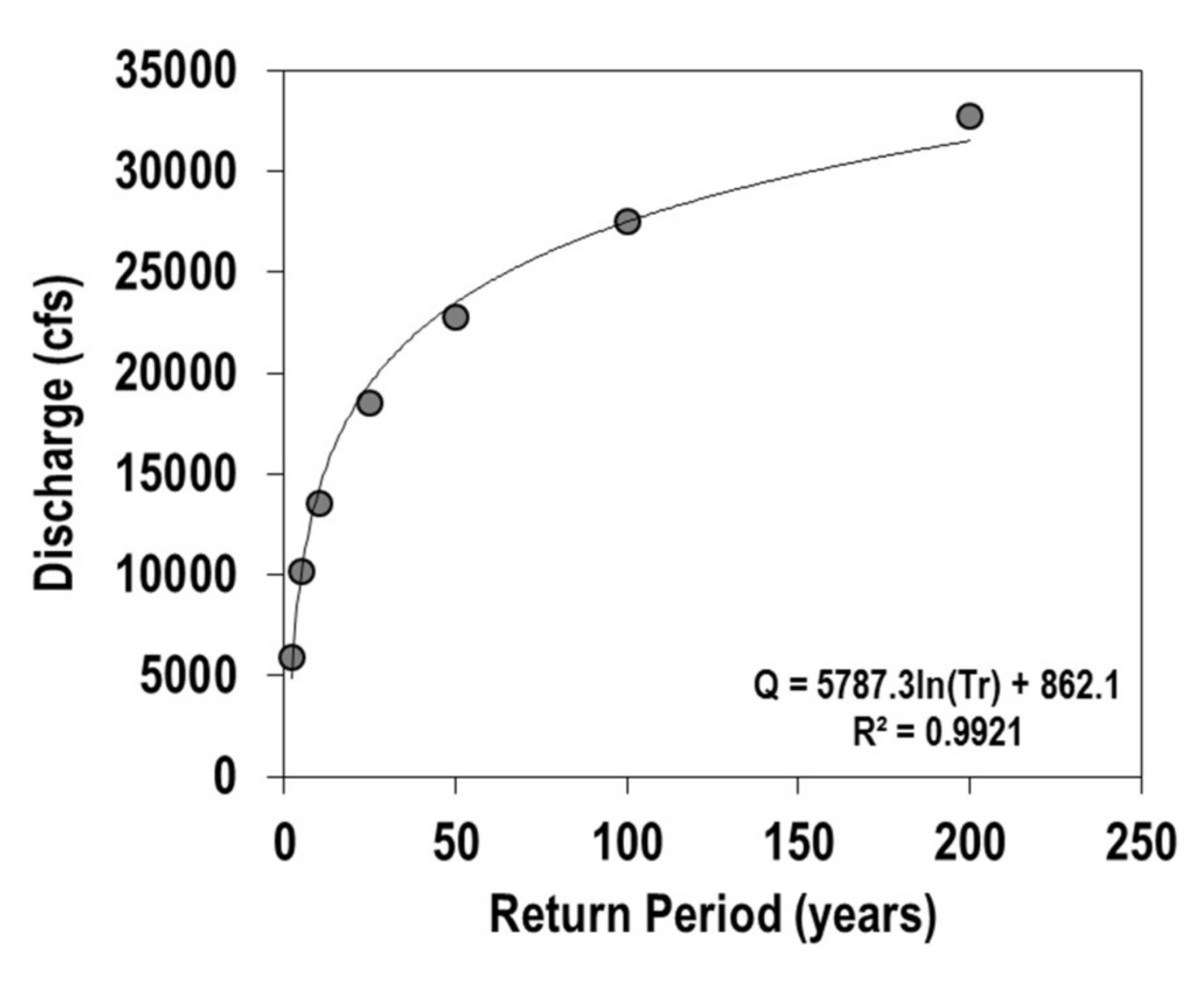
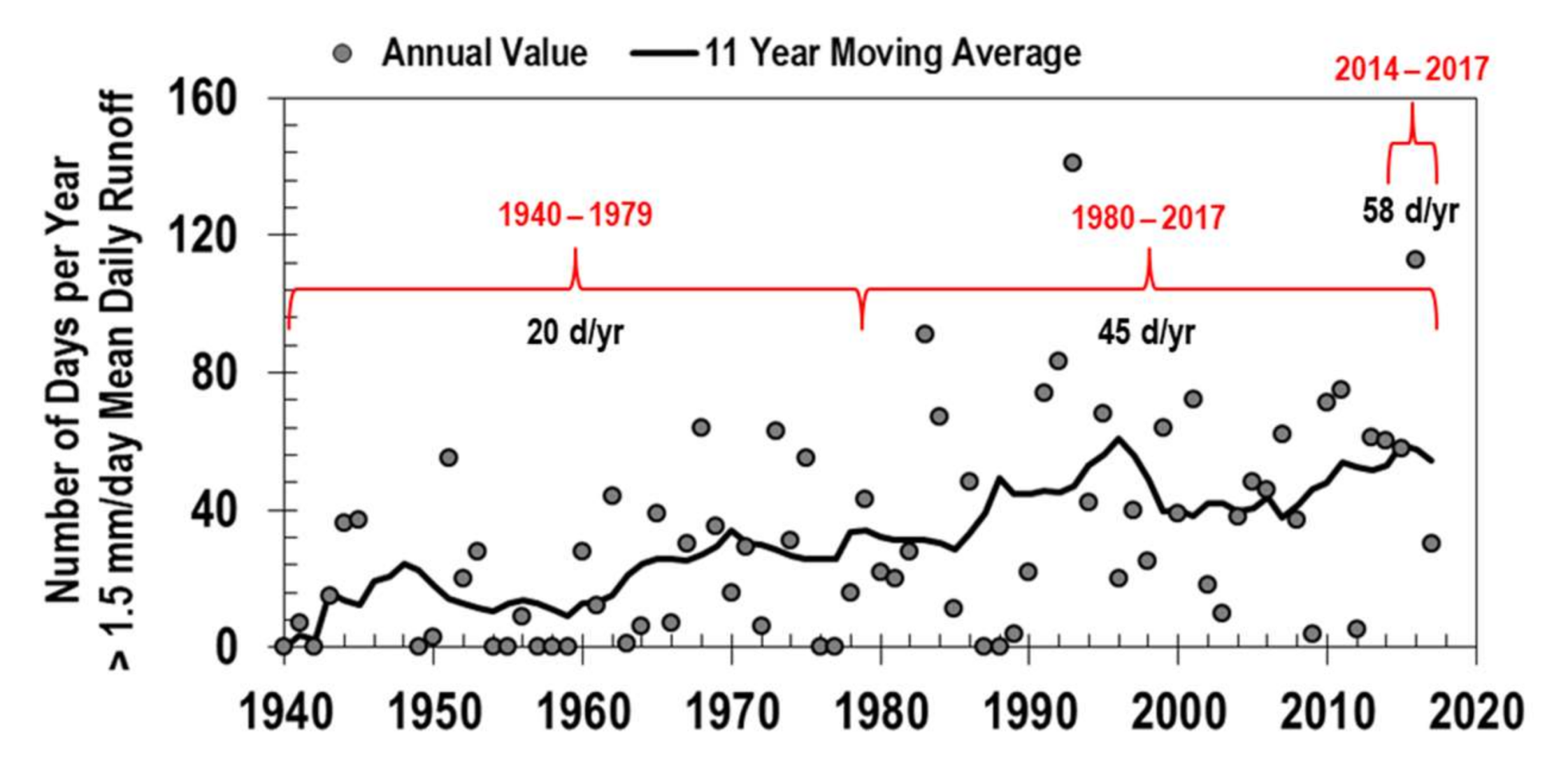
References
- Wilkinson, B.H.; McElroy, B.J. The impact of humans on continental erosion and sedimentation. Bull. Geol. Soc. Am. 2007, 119, 140–156. [Google Scholar] [CrossRef]
- Montgomery, D.R. Is agriculture eroding civilization’s foundation? GSA Today 2007, 17, 4–9. [Google Scholar] [CrossRef]
- Hooke, R.L. On the history of human as geomorphic agent. Geology 2000, 28, 843–846. [Google Scholar] [CrossRef]
- Wilkinson, B.H. Humans as geologic agents: A deep-time perspective. Geology 2005, 33, 161–164. [Google Scholar] [CrossRef]
- Syvitski, J.P.M.; Vörösmarty, C.J.; Kettner, A.J.; Green, P. Impact of humans on the flux of terrestrial sediment to the global coastal ocean. Science 2005, 308, 376–380. [Google Scholar] [CrossRef] [PubMed]
- Owens, P.N.; Batalla, R.J.; Collins, A.J.; Gomez, B.; Hicks, D.M.; Horowitz, A.J.; Kondolf, G.M.; Marden, M.; Page, M.J.; Peacock, D.H.; et al. Fine-grained sediment in river systems: Environmental significance and management issues. River Res. Appl. 2005, 21, 693–717. [Google Scholar] [CrossRef]
- Belmont, P.; Gran, K.B.; Schottler, S.P.; Wilcock, P.R.; Day, S.S.; Jennings, C.; Lauer, J.W.; Viparelli, E.; Willenbring, J.K.; Engstrom, D.R.; et al. Large shift in source of fine sediment in the upper Mississippi River. Environ. Sci. Technol. 2011, 45, 8804–8810. [Google Scholar] [CrossRef] [PubMed]
- Dean, D.J.; Schmidt, J.C. The role of feedback mechanisms in historic channel changes of the lower Rio Grande in the Big Bend region. Geomorphology 2011, 126, 333–349. [Google Scholar] [CrossRef]
- Schottler, S.P.; Ulrich, J.; Belmont, P.; Moore, R.; Lauer, J.W.; Engstrom, D.R.; Almendinger, J.E. Twentieth century agricultural drainage creates more Erosive rivers. Hydrol. Process. 2014, 28, 1951–1961. [Google Scholar] [CrossRef]
- Lauer, J.W.; Echterling, C.; Lenhart, C.; Belmont, P.; Rausch, R. Air-photo based change in channel width in the Minnesota River basin: Modes of adjustment and implications for sediment budget. Geomorphology 2017, 297, 170–184. [Google Scholar] [CrossRef]
- Kelly, S.A.; Takbiri, Z.; Belmont, P.; Foufoula-Georgiou, E. Human amplified changes in precipitation-runoff patterns in large river basins of the Midwestern United States. Hydrol. Earth Syst. Sci. Discuss. 2017, 1–37. [Google Scholar] [CrossRef]
- Nakamura, F.; Seo, J., II; Akasaka, T.; Swanson, F.J. Large wood, sediment, and flow regimes: Their interactions and temporal changes caused by human impacts in Japan. Geomorphology 2017, 279, 176–187. [Google Scholar] [CrossRef]
- Call, B.C.; Belmont, P.; Schmidt, J.C.; Wilcock, P.R. Changes in floodplain inundation under nonstationary hydrology for an adjustable, alluvial river channel. Water Resour. Res. 2017, 53, 3811–3834. [Google Scholar] [CrossRef]
- Walling, D.E.; Owens, P.N.; Carter, J.; Leeks, G.J.L.; Lewis, S.; Meharg, A.A.; Wright, J. Storage of sediment-associated nutrients and contaminants in river channel and floodplain systems. Appl. Geochem. 2003, 18, 195–220. [Google Scholar] [CrossRef]
- Peck, M.; Gibson, R.W.; Kortenkamp, A.; Hill, E.M. Sediments Are Major Sinks of Steroidal Estrogens in Two United Kingdom Rivers. Environ. Toxicol. Chem. 2004, 23, 945. [Google Scholar] [CrossRef] [PubMed]
- Perks, M.T.; Owen, G.J.; Benskin, C.M.W.H.; Jonczyk, J.; Deasy, C.; Burke, S.; Reaney, S.M.; Haygarth, P.M. Dominant mechanisms for the delivery of fine sediment and phosphorus to fluvial networks draining grassland dominated headwater catchments. Sci. Total Environ. 2015, 523, 178–190. [Google Scholar] [CrossRef] [PubMed] [Green Version]
- Wood, P.; Armitage, P. Biological Effects of Fine Sediment in the Lotic Environment. Environ. Manag. 1997, 21, 203–217. [Google Scholar] [CrossRef]
- Bilotta, G.S.; Brazier, R.E. Understanding the influence of suspended solids on water quality and aquatic biota. Water Res. 2008, 42, 2849–2861. [Google Scholar] [CrossRef] [PubMed]
- Bennett, E.M.; Carpenter, S.R.; Caraco, N.F. Human Impact on Erodable Phosphorus and Eutrophication: A Global Perspective. Bioscience 2001, 51, 227. [Google Scholar] [CrossRef]
- United States Environmental Protection Agency (USEPA). National Water Quality Inventory: Report to Congress; EPA 841-R-16-011; USEPA: Washington, DC, USA, 2017.
- Belmont, P.; Foufoula-Georgiou, E. Solving water quality problems in agricultural landscapes: New approaches for these nonlinear, multiprocess, multiscale systems. Water Resour. Res. 2017, 53, 2585–2590. [Google Scholar] [CrossRef]
- Burt, T.P.; Allison, R.J. Sediment Cascades: An Integrated Approach. Sediment Cascades Integr. Approach 2009, 1–471. [Google Scholar] [CrossRef]
- Smith, S.M.C.; Belmont, P.; Wilcock, P.R. Closing the Gap Between Watershed Modeling, Sediment Budgeting, and Stream Restoration. In Stream Restoration in Dynamic Fluvial Systems: Scientific Approaches, Analyses, and Tools; Simon, A., Bennett, S., JM, C., Eds.; AGU: Washington, DC, USA, 2011; pp. 293–317. [Google Scholar]
- Kelley, D.W.; Brachfeld, S.A.; Nater, E.A.; Wright, H.E. Sources of sediment in Lake Pepin on the Upper Mississippi River in response to Holocene climatic changes. J. Paleolimnol. 2006, 35, 193–206. [Google Scholar] [CrossRef]
- Kelley, D.W.; Nater, E.A. Source apportionment of lake bed sediments to watersheds in an Upper Mississippi basin using a chemical mass balance method. Rivers 2000, 41, 277–292. [Google Scholar] [CrossRef]
- Wilcock, P. Identifying Sediment Sources in the Minnesota River Basin; Minnesota Pollution Control Agency: St. Paul, MN, USA, 2009. [Google Scholar]
- Gunderson, L.; Finley, R.; Bourne, H.; Lofton, D. Sediment Reduction Strategy for the Minnesota River Basin and South Metro Mississippi River: Establishing a Foundation for Local Watershed Planning to Reach Sediment TMDL Goals; Minnesota Pollution Control Agency: Saint Paul, MN, USA, 2014. [Google Scholar]
- Gran, K.; Belmont, P.; Bevis, M.; Cho, S.J.; Heitkamp, B.; Hobbs, B.; Marr, J.; Mielke, S.; Mitchell, N.; Kumarasamy, K.; et al. Collaborative for Sediment Source Reduction—Greater Blue Earth River Basin: Summary of Findings. Available online: http://www.bwsr.state.mn.us/drainage/dwg/resources/CSSR_Final_Report.pdf (accessed on 26 March 2018).
- Vaughan, A.A.; Belmont, P.; Hawkins, C.P.; Wilcock, P. Near-Channel Versus Watershed Controls on Sediment Rating Curves. J. Geophys. Res. Earth Surf. 2017, 122, 1901–1923. [Google Scholar] [CrossRef]
- Cho, S.J. Development of Data-Driven, Reduced-Complexity Watershed Simulation Models to Address Agricultural Non-Point Source Sediment Pollution in Southern Minnesota. Ph.D. Thesis, Johns Hopkins University, Baltimore, MD, USA, 2017. [Google Scholar]
- Ellison, C.A.; Savage, B.E.; Johnson, G.D. Suspended-sediment concentrations, loads, total suspended solids, turbidity, and particle-size fractions for selected rivers in Minnesota, 2007 through 2011. U.S. Geol. Surv. Sci. Investig. Rep. 2014, 5205, 43. [Google Scholar]
- Day, S.S.; Gran, K.B.; Belmont, P.; Wawrzyniec, T. Measuring bluff erosion part 2: Pairing aerial photographs and terrestrial laser scanning to create a watershed scale sediment budget. Earth Surf. Process. Landf. 2013, 38, 1068–1082. [Google Scholar] [CrossRef]
- Day, S.S.; Gran, K.B.; Belmont, P.; Wawrzyniec, T. Measuring bluff erosion part 1: Terrestrial laser scanning methods for change detection. Earth Surf. Process. Landf. 2013, 38, 1055–1067. [Google Scholar] [CrossRef]
- Wolman, M.G.; Miller, J.P. Magnitude and Frequency of Forces in Geomorphic Processes. J. Geol. 1960, 1, 54–74. [Google Scholar] [CrossRef]
- Runkel, A.C.; Meyer, G.N.; Lusardi, B.A. C-26 Geologic Atlas of Blue Earth County, Minnesota [Part A]; Minnesota Geological Survey: St Paul, MN, USA, 2011. [Google Scholar]
- Gran, K.B.; Belmont, P.; Day, S.S.; Finnegan, N.; Jennings, C.; Lauer, J.W.; Wilcock, P.R. Landscape evolution in south-central Minnesota and the role of geomorphic history on modern erosional processes. GSA Today 2011, 21, 7–9. [Google Scholar] [CrossRef]
- Gran, K.B.; Belmont, P.; Day, S.S.; Jennings, C.; Johnson, A.; Perg, L.; Wilcock, P.R. Geomorphic evolution of the Le Sueur River, Minnesota, USA, and implications for current sediment loading. In Management and Restoration of Fluvial Systems with Broad Historical Changes and Human Impacts: Geological Society of America Special Paper 451; James, L.A., Rathburn, S.L., Whittecar, G.R., Eds.; GeoScienceWorld: Mclea, VA, USA, 2009; pp. 119–130. ISBN 0072-1077r978-0-8137-2451-5. [Google Scholar]
- Schaffrath, K.R.; Belmont, P.; Wheaton, J.M. Landscape-scale geomorphic change detection: Quantifying spatially variable uncertainty and circumventing legacy data issues. Geomorphology 2015, 250, 334–348. [Google Scholar] [CrossRef]
- Smith, M.W.; Carrivick, J.L.; Quincey, D.J. Structure from motion photogrammetry in physical geography. Prog. Phys. Geogr. 2015, 40, 247–275. [Google Scholar] [CrossRef]
- Westoby, M.J.; Brasington, J.; Glasser, N.F.; Hambrey, M.J.; Reynolds, J.M. “Structure-from-Motion” photogrammetry: A low-cost, effective tool for geoscience applications. Geomorphology 2012, 179, 300–314. [Google Scholar] [CrossRef] [Green Version]
- Fonstad, M.A.; Dietrich, J.T.; Courville, B.C.; Jensen, J.L.; Carbonneau, P.E. Topographic structure from motion: A new development in photogrammetric measurement. Earth Surf. Process. Landf. 2013, 38, 421–430. [Google Scholar] [CrossRef]
- Carrivick, J.L.; Smith, M.W.; Quincey, D.J. Structure from Motion in the Geosciences; Wiley-Blackwell: Singapore, 2016; ISBN 978-1-118-89584-9. [Google Scholar]
- Girardeau-Montaut, D. Cloud Compare—3D point cloud and mesh processing software. Available online: http://www.danielgm.net/cc/ (accessed on 26 March 2018).
- Brasington, J.; Vericat, D.; Rychkov, I. Modeling river bed morphology, roughness, and surface sedimentology using high resolution terrestrial laser scanning. Water Resour. Res. 2012, 48. [Google Scholar] [CrossRef]
- Wheaton, J.M.; Brasington, J.; Darby, S.E.; Sear, D.A. Accounting for uncertainty in DEMs from repeat topographic surveys: Improved sediment budgets. Earth Surf. Process. Landf. 2010, 35, 136–156. [Google Scholar] [CrossRef]
- Castillo, C.; Pérez, R.; James, M.R.; Quinton, J.N.; Taguas, E.V.; Gómez, J.A. Comparing the Accuracy of Several Field Methods for Measuring Gully Erosion. Soil Sci. Soc. Am. J. 2012, 76, 1319. [Google Scholar] [CrossRef] [Green Version]
- Larsen, I.J.; Montgomery, D.R.; Korup, O. Landslide erosion controlled by hillslope material. Nat. Geosci. 2010, 3, 247–251. [Google Scholar] [CrossRef]
- Hovius, N.; Stark, C.P.; Allen, P.A. Sediment flux from a mountain belt derived by landsliding mapping. Geology 1997, 25, 231–234. [Google Scholar] [CrossRef]
- Lavé, J.; Burbank, D. Denudation processes and rates in the Transverse Ranges, southern California: Erosional response of a transitional landscape to external and anthropogenic forcing. J. Geophys. Res. Earth Surf. 2004, 109. [Google Scholar] [CrossRef]
- Stark, C.P.; Guzzetti, F. Landslide rupture and the probability distribution of mobilized debris volumes. J. Geophys. Res. Earth Surf. 2009, 114, 1–16. [Google Scholar] [CrossRef]
- Doyle, M.W.; Shields, D.; Boyd, K.F.; Skidmore, P.B.; Dominick, D. Channel-Forming Discharge Selection in River Restoration Design. J. Hydraul. Eng. 2007, 133, 831–837. [Google Scholar] [CrossRef]
- Minnesota Department of Natural Resources September 20–22, 2016 Heavy Rain. Available online: http://www.dnr.state.mn.us/climate/journal/160921_22_heavy_rain.html (accessed on 10 January 2018).
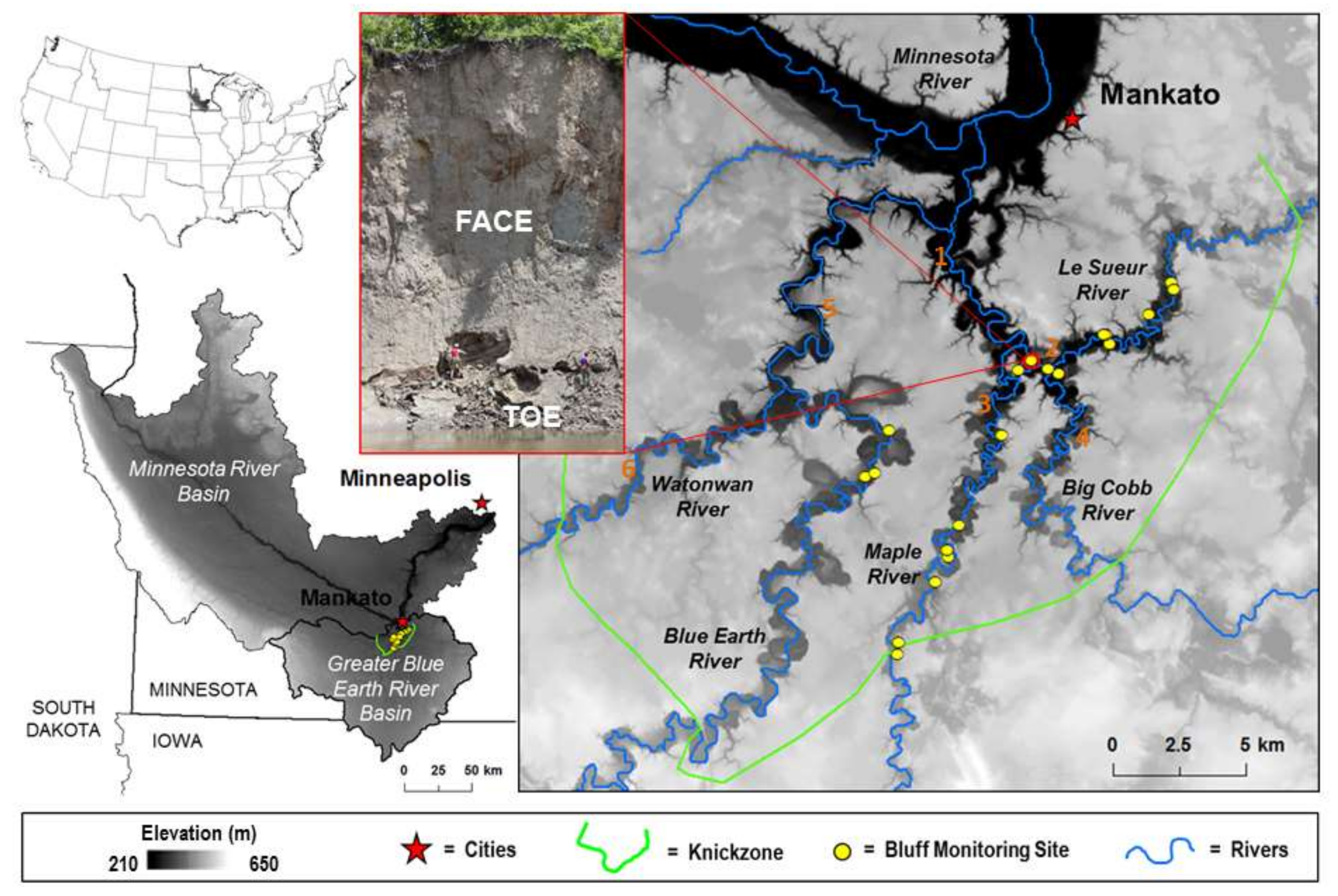


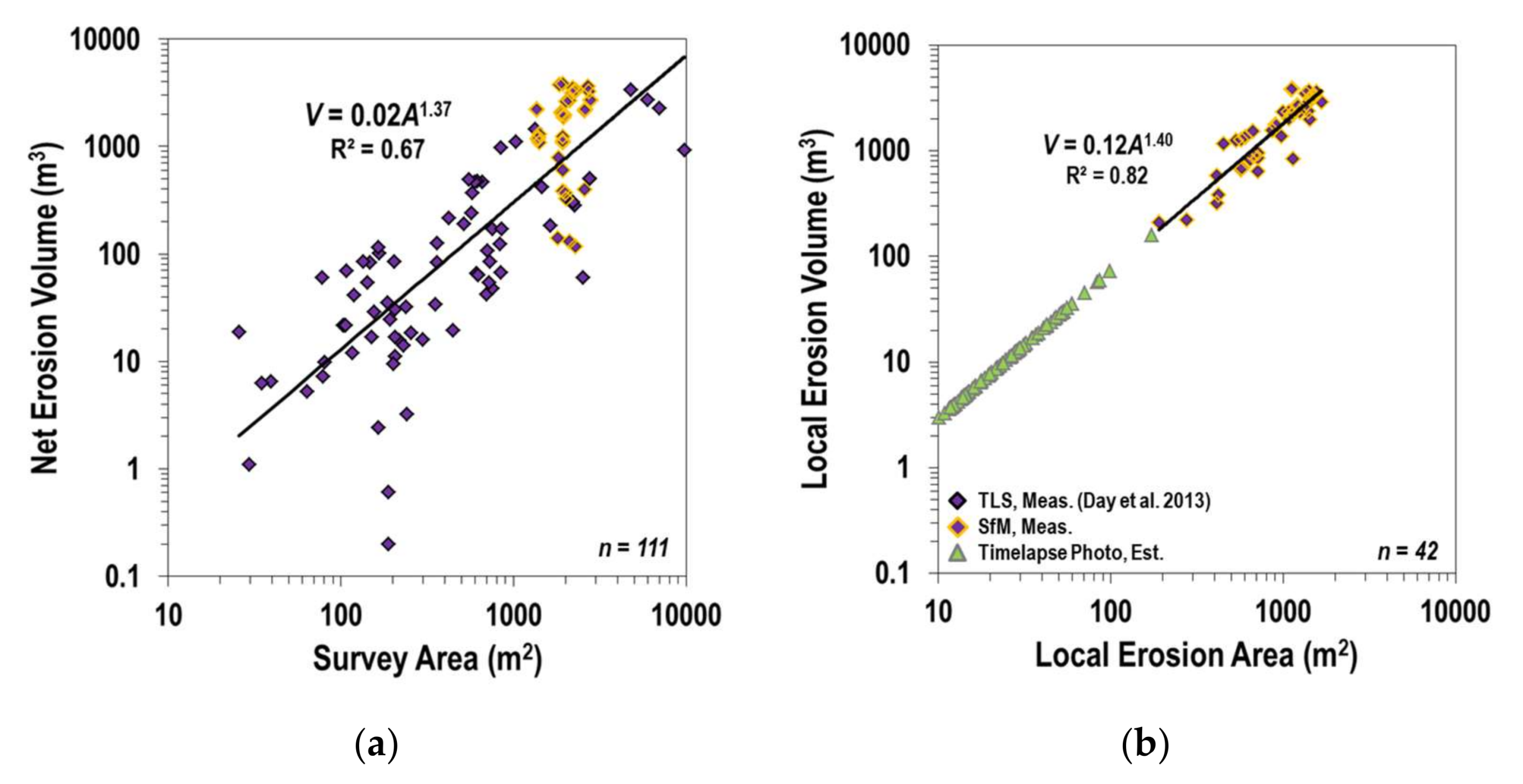
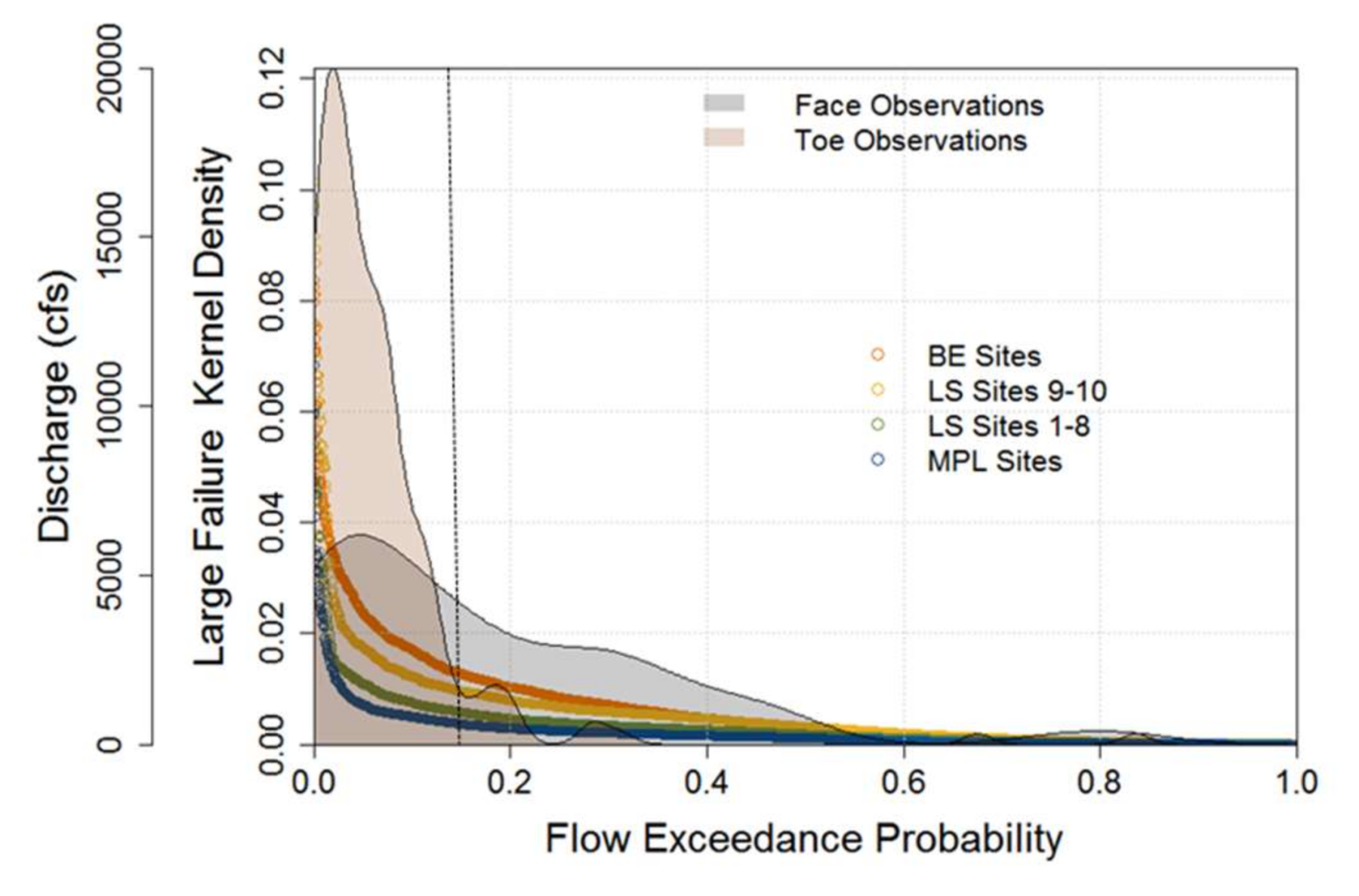
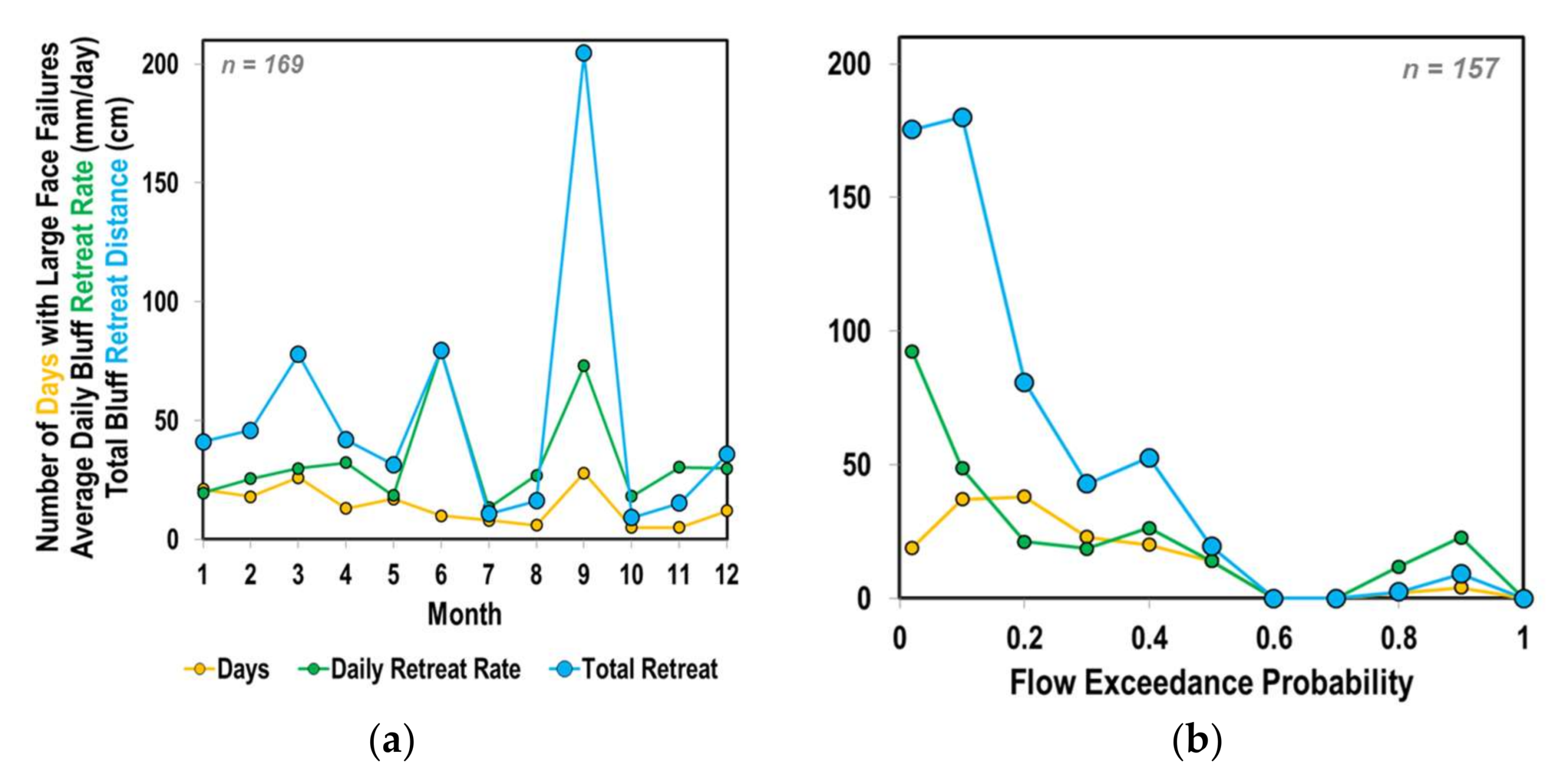
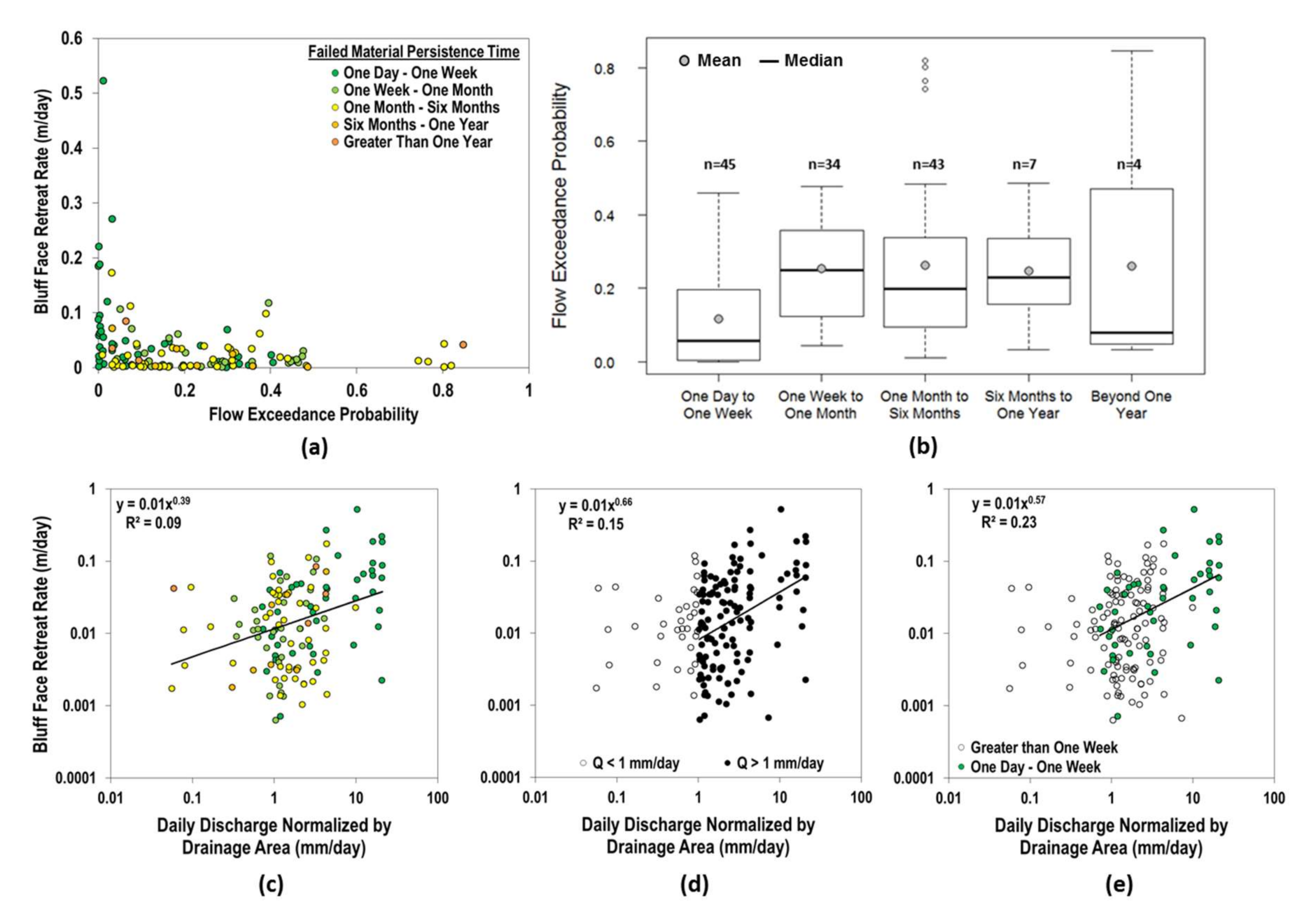
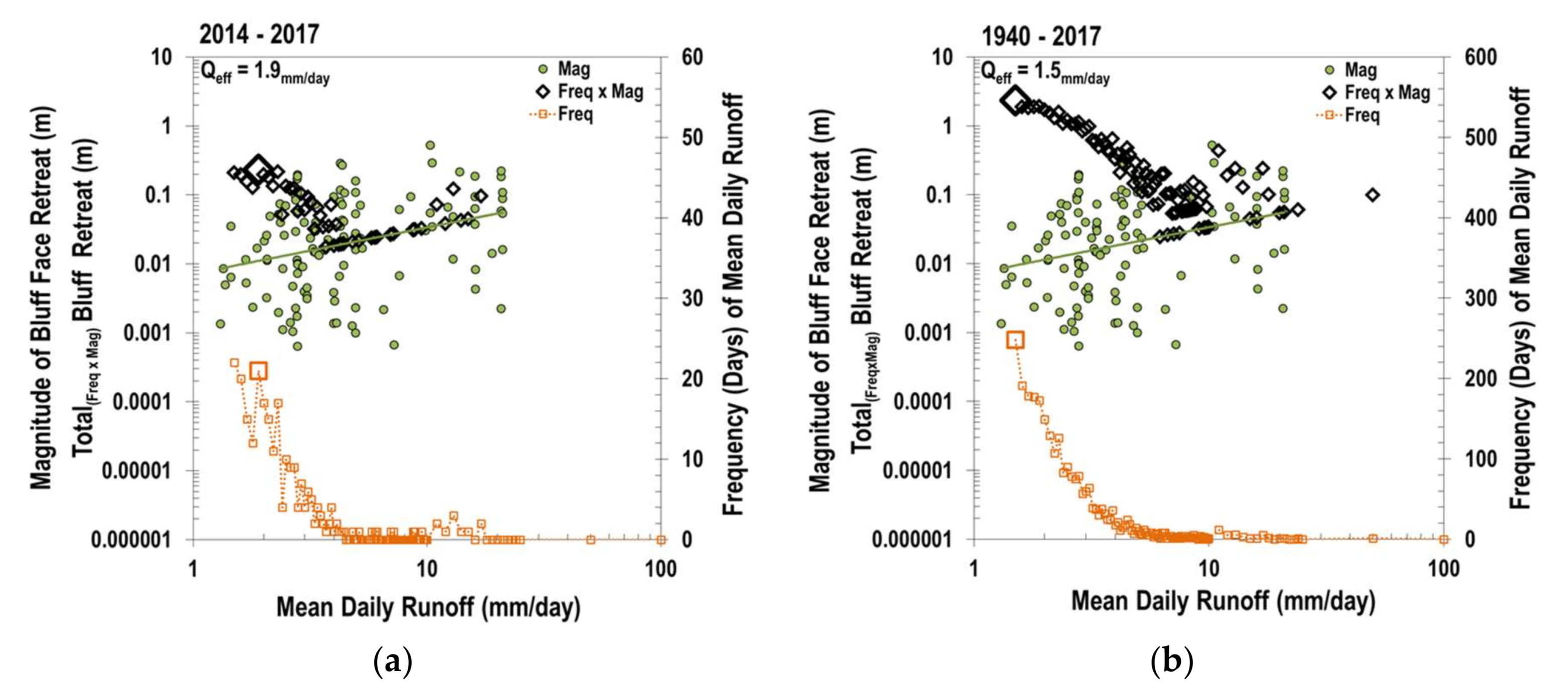
| Site Name | Survey Date | Number of Survey Photos | Number of GCPs | GCP RMSE (m) | Total Dense Cloud Points (×106) | Average Cloud Density (pts/cm2) |
|---|---|---|---|---|---|---|
| LS9 1 | 6/15/2014 | 46 | 9 | 0.024 | 28.4 | 1.4 |
| LS9 | 7/3/2014 | 52 | 11 | 0.087 | 35.1 | 1.5 |
| LS9 | 5/8/2015 | 55 | 9 | 0.013 | 30.3 | 1.3 |
| LS9 | 7/12/2015 | 60 | 11 | 0.028 | 17.9 | 0.6 |
| LS9 | 5/24/2016 | 54 | 10 | 0.031 | 17.7 | 0.7 |
| LS9 | 10/22/2016 | 100 | 11 | 0.024 | 22.0 | 0.8 |
| LS9 | 5/17/2017 | 108 | 10 | 0.010 | 47.1 | 1.6 |
| LS10 2 | 6/15/2014 | 51 | 9 | 0.015 | 31.9 | 2.2 |
| LS10 | 7/3/2014 | 110 | 13 | 0.018 | 35.1 | 1.7 |
| LS10 | 5/9/2015 | 51 | 11 | 0.010 | 38.6 | 2.0 |
| LS10 | 7/10/2015 | 50 | 11 | 0.073 | 19.9 | 0.7 |
| LS10 | 5/24/2016 | 63 | 10 | 0.018 | 26.1 | 1.0 |
| LS10 | 10/22/2016 | 100 | 13 | 0.018 | 20.6 | 0.7 |
| LS10 | 5/17/2017 | 91 | 5 3 | 0.016 | 38.7 | 1.3 |
© 2018 by the authors. Licensee MDPI, Basel, Switzerland. This article is an open access article distributed under the terms and conditions of the Creative Commons Attribution (CC BY) license (http://creativecommons.org/licenses/by/4.0/).
Share and Cite
Kelly, S.A.; Belmont, P. High Resolution Monitoring of River Bluff Erosion Reveals Failure Mechanisms and Geomorphically Effective Flows. Water 2018, 10, 394. https://doi.org/10.3390/w10040394
Kelly SA, Belmont P. High Resolution Monitoring of River Bluff Erosion Reveals Failure Mechanisms and Geomorphically Effective Flows. Water. 2018; 10(4):394. https://doi.org/10.3390/w10040394
Chicago/Turabian StyleKelly, Sara Ann, and Patrick Belmont. 2018. "High Resolution Monitoring of River Bluff Erosion Reveals Failure Mechanisms and Geomorphically Effective Flows" Water 10, no. 4: 394. https://doi.org/10.3390/w10040394





